I mentioned in the first post that two converging factors occasioned me to begin writing this series: the notion that I could neutralize the urge to take up Magic: The Gathering again by writing about Magic, and a bout with depression. There was a third factor I left unmentioned: I'd been unemployed since November. (That contributed to the depression, certainly.)
But I got a new job a couple of weeks ago. My days have structure imposed on them again. I'm biking to work, and the weather has become markedly less dreary. I don't feel like sleeping all the time anymore.
I wrote most of this during the winter, and as I get closer to the end I'm finding I lot of paragraphs that I let taper off, intending to finish them later on—meaning that now I have to do more than just try to tidy these things up before posting them. And now that I'm coming back to life, I'm remembering there's a lot more I want to read, think, and write about other than Magic, and now I have a time constraint.
There's two of these left, so I might as well finish them, but I'd like to have a bit of room while I readjust to the world of living and ponder other projects to occupy my time. Part seven will be up in two weeks.
___________
After Mirrodin, possibly the strangest Magic: The Gathering block of all time (at least in terms of its setting), the brain trust at Wizards of the Coast decided to bring things back down to earth. More specifically, the part of Earth called Japan. Why not? Anime had crept into the mainstream, Gwen Stefani was signing about Harajuku Girls, and there was money to be made by capturing a trend. So Wizards of the Coast turned out the Kamigawa block: Champions of Kamigawa (October 2004), Betrayers of Kamigawa (February 2005), and Saviors of Kamigawa (June 2005).




I'm not sure I have much to say about this one.
For the first time since Arabian Nights, Magic attempts to translate the mythology and aesthetic of a real-world culture during a period in real-world history into a motif for the latest iteration of its collectible game product.
Mirage? No, I don't think Mirage counts. To my understanding, the cards were all fully designed before the Africana theme was grafted on to it, and Jamuraa was every inch of it a fantasy pastiche: nobody at Magic R&D spent months researching the Kingdom of Kongo, Nubian Empire, etc. in order to convincingly imitate their folkways and lore. No Swahili words or Oroma names pepper the text. Moreover, its mechanical identity and aesthetic were developed independently: all of the rules text was in place before the creative department got their hands on it. Kamigawa, on the other hand, began with the concept of a Japan-themed set.
I'm even a little reluctant to place Arabian Nights and the Kamigawa block in the same category. For one thing, Arabian Nights has no mechanical themes designed to intersect with its Arabic folkloric aesthetic (that sort of thing hadn't occurred to anybody yet), whereas Kamigawa progressively introduces new keywords and abilities purposefully developed to amplify the flavor of the setting. For another, Arabian Nights was a readymade: Bazaar of Baghdad, Aladdin's Lamp, Ali Baba, Moorish Cavalry, etc. are all cards that appear in Arabian Nights. Kamigawa is Japan World inside and out (Oni! Kami! Yamazaki! Orochi! Kirin! Nine-tailed foxes! Animism gone ballistic! Homework was done!), but it's not allowed to call itself Japan—even though the success of its creative direction depended on the recognizability and accuracy of its Japanese-ness.
Even though this is a first for Magic design, I'm neither qualified to nor really interested in examining how effectively the Kamigawa block captures the vibe of feudal Japan (or, more precisely, how effectively it captures popular conceptions feudal Japan), and it doesn't utilize the particularities of the format to do anything special to that end. Then again: anyone who claims that a batch of game mechanics somehow "feels" like a foreign culture deserves the side-eye.
With a little nomenclatural shuffling, the mechanical themes of Kamigawa—an emphasis on legendary cards, the "spirit" creature type, abilities like Bushido and Ninjutsu—could have hypothetically worked just as well as the substratum for a block based on, say, the Trojan War. For that matter, a fighting game like Darkstalkers could just as well have had Tokusatsu superhero graphics grafted onto its hitboxes, Final Fantasy Tactics could have been set in a cyberpunk world, etc. There are very few rules-based games (tabletop, electronic, or otherwise) whose specific veneer indispensably conditions its mechanics, and vice versa—and yet an aesthetic veneer is the sine qua non for engaging with a game's technical aspects.
This is to say that the gestalt of a given Magic set's mechanics and aesthetic usually yield a superior product when the aesthetics are determined by the mechanics, rather than the other way around. But even as a block that started with a stylistic conceit and worked downward, Kamigawa represents an improvement. It went all in. For all it did to expand on the mythos, the Urza block is less than the combination of its aesthetic and mechanics, at least when we compare it to Kamigawa. So much of Urza's flavor consists of asterisks pointing towards a body of lore that exists elsewhere, and the cards' performance and the conceptual edifice of Urza's journey don't add up to more than the sum of their parts.
What I mean by all of this: while it would have been possible for all of Kamigawa's rules text to have been scrubbed of all its Japan-themed references and repurposed as the basis for a set with a completely different vibe, doing so would be harder than it would with, say, the Odyssey block.




Still: this is a set where my not having been around for its release disqualifies me from saying anything about it. When Kamigawa was in standard, I was spending most of my leisure time smoking weed, playing King of Fighters, and making sprite comics—surely if I had some sort of personal history with these cards, they'd mean more to me than "this sure is Magic: The Gathering Does Japan." It doesn't help that Kamigawa cards very seldom appeared in any EDH playgroups I've been a part of; I wasn't around for Zendikar either, but I've encountered enough of its critters and quests in the wild that I came to associate an in-game functionality with its aesthetic. Same for Ravnica (it's inescapable), and to lesser extents, Odyssey/Onslaught and Lorwyn—Odyssey/Onslaught because the cards are still popular but the vibe is elusive, and Lorwyn because the vibe is palpable but my friends use(d) its cards infrequently.
So...yeah. Kamigawa. It's Magic: The Gathering Does Japan. What else is there to say—except to repeat a bit of chatter from some message board or other, speculating that one of the reasons for its lukewarm reception was that people weren't prepared for outlandish weirdness of the spirit cards, which appeared in tremendous numbers. To the designers' credit, this should have pleased the Japan Club players in the ranks of its fanbase: traditional depictions of supernatural beings in Japanese woodblock prints are, to Western eyes, fucking weird, and I'm glad Magic's art department didn't bowdlerize Kamigawa's off-brand Shinto manifestations. (Is anyone surprised that Neon Dynasty's kami were noticeably more mundane looking?)
Speaking of the art department: Kamigawa's illustrations are markedly more varied and interesting than Onslaught's or Mirrodin's—and yet art director Jeremy Cranford, remained at the helm. You might remember us mentioning earlier that he told artist Rebecca Guay her contributions were no longer wanted. You might also notice that a few of the Kamigawa cards displayed here feature Guay's artwork. Since her debut in Alliances, Guay has been one of Magic's most popular artists, and she didn't mince words when her fans wanted to know why her work stopped appearing in new sets.
In the joke set Unhinged, released between Champions of Kamigawa and Betrayers of Kamigawa, the cards Persecute Artist and Fascist Art Director were ostensibly put into circulation as a mea cupla from Wizards, lightheartedly acknowledging the egg on its face—but notwithstanding their parodic tone, they represent the company publicly hanging Cranford out to dry. (Not coincidentally, he didn't work on Unhinged.) Coming from an outfit that's usually so reluctant to air its dirty laundry, this was vicious.
My pet theory is that Cranford let Guay back on and became a more permissive art director for the remainder of his tenure (through 2006) because he knew he was in the hot seat—but who knows?




We can also talk about Kamigawa as an inflection point in Magic's protracted struggle to reform black.
From the beginning, black cards were designated as "evil." Later on, when some public-facing representatives of the creative team tried to push back against the notion, nobody took them seriously. Black cards summon vampires and demons, and cast spells that generally don't do good things to their targets. Phyrexia was black. The Cabal was black. Most of the villains for the first decade of Magic's lifespan were black-aligned. Obviously black is evil.
Obversely, white is obviously good. Most of the good guys in the Weatherlight Saga (Gerrard, Sisay, Hanna, Orim) were white or white-aligned. The civilized nations of Dominaria (Kjeldor, Zhalfir, Femerf, Benalia) were associated with white. Serra's realm was a wellspring of white mana. White heals, empowers, and summons angels. The idea that white didn't necessarily stand for truth, justice, and good will in the Magic universe rang as hollow as black not representing its monsters, sociopaths, and Nazis.
The Otaria saga made some effort to switch things up: Kamahl, the Odyssey block's protagonist, was red-aligned while the main villain Laquatus was blue-aligned. Mirrodin gave us a green-aligned hero (Glissa) and another blue-aligned antagonist (Memnarch). The Kamigawa block finally gives us a black-aligned hero (Toshiro Umezawa) and a white-aligned villain (Lord Konda), though the cards themselves give little indication of Umezawa's integral role in the plot. (Once again, you have to read the books to learn exactly how the Kami War resolves.)
If white's moral alignment equates more or less to the "lawful good" of Dungeons & Dragons, how can a story's bad guy be white? That's a good question, and Kamigawa gives a pretty good answer. Konda does indeed prioritize the welfare of his people in every decision he makes as a ruler, and presided over an era of peace and prosperity. But as he aged, he began to worry about what might happen after he died. The most effective way to safeguard the status quo, Konda reasoned, was to stay in charge in perpetuity, which meant he needed to figure out how to live forever. So he stole an artifact from the spirit world that made him immortal, enraging the spirits and gods of Kamigawa. When they retaliated by declaring war on the mortal realm, Konda stuck to his guns, confident that the living peoples of the realm (under his enlightened guidance) could weather the storm and bend the kami into compliance.
On the other hand, the ronin Toshiro Umezawa was an unscrupulous free agent whose only loyalty was to himself, and who held nothing sacred except his own interests. But, in the course of looking out for himself and saving his own ass from all the people he'd pissed off over the years, he made himself instrumental to ending the war in such a way that Konda was deposed and destroyed while the spirit world was placed under new management, thus ending hostilities between the mortal and spirit realms.
I can't but read this as a typically Western take on a Japanese-inspired narrative: in a society of rigid conformity, the nonconforming individualist ends up being the hero.



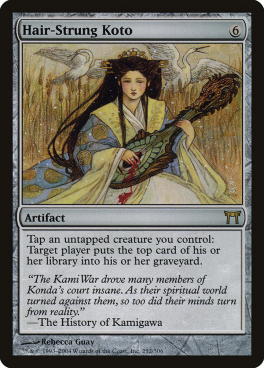
So, once again, R&D endeavored to make the following block more reasonably powered, and once again, they overcompensated. For a lot of players, no amount of Japanese mythological seasoning could have washed out the bad taste Kamigawa left on their palates. (A decade and a half had to pass before Wizards would countenance the idea of revisiting Japan World, and it had to receive a cyberpunk makeover just to be on the safe side.)
And, as before, Magic triumphantly emerged from the doghouse with a popular set emphasizing multicolor cards. "Popular" might be an understatement: it was one of the best-received sets in the game's history, beloved enough to have been revisited twice (so far), an honor it currently shares with only Dominaria, Zendikar, and Innistrad.
Let's start with the superficial. Remember how Mercadian Masques had a quasi-realized city theme? Yeah, me neither. Ravnica gives the concept another try, and goes all in. The entire planet is a city. All of it, from pole to pole. There are no oceans, no deserts, no bare mountain peaks, and the closest thing to wildernesses are greenbelts and long-derelict neighborhoods.
Its plains? City. Swamps? City. Islands? City. It's all city.






On the face of it, it sounds like sacrificing geographic variety necessitates sacrificing the diverse cast of fantasy sapiens that have been integral to Magic for years. If there are no lonely mountain chains, it would seem to follow that there are no goblins, ogres, or dragons. No desolate swamps, no zombie hordes or demons. No ancient forests, no elves, wurms, or elementals.
But that's not how Ravnica works. Goblins? They live in the city. Elves? They live in the city. Giant cyclopes? They live in the city. Vampires? Angels? Gorgons? Anthropomorphic elephants? Demons? Dragons? They live in the city. One imagines that somebody from Ravnica would happily take a vacation to Manhattan for some peace and quiet.
I'm thinking the city followed from Ravnica's other conceit: guilds. (It's in the name, after all.) Way back in Mirage, where there was a cycle of Zhalfirin guildmages, representing five orders of workaday wizards employed in greasing the nation's wheels. Each of them came in one color, but activating their abilities depended on running at least one of that color's allies. They were a very small part of Mirage, but the concept was solid. Ravnica takes that concept and raises it to the tenth power.
The guilds run everything in Ravnica—which is why the place had to be a city. If there were an acre of wilderness on Ravnica, that would result in an acre where the guilds didn't matter. And the guilds had to be placed front and center in the lore, because the sets' mechanics are constructed entirely around them.
Hmm. If we showcase even a couple of the guilds, we'll have to show them all. Let's go down the list of their representatives:





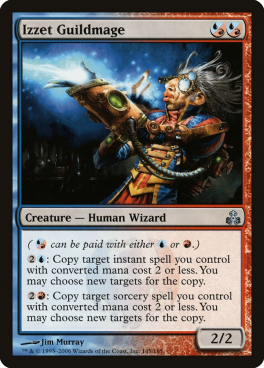

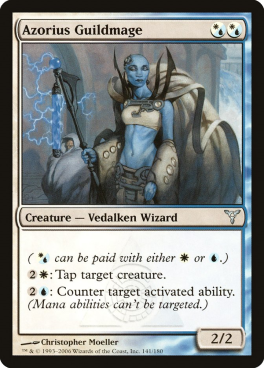


They're not introduced all at once. Four of them (and their signature mechanics) are introduced in Ravnica: City of Guilds. Three more follow in Guildpact, and the last three in Dissension. The designers made the smart (though obvious) decision to have each of the unrepresented guilds mentioned in the flavor text before they debuted, teasing their names and roles—but not their colors.
Color pairs are Ravnica's gimmick. Ten of them. In addition to accessing the usual archetypal talents of each color, the guilds all have characteristic creature/class tribes and a unique mechanic. The Graft ability is exclusive to Simic critters, bringing them into play with powerups that they can pass on to other creatures. Some Izzet spells have the Replicate attribute, letting you cast them more than once by paying an extra cost. And so on.
Some of the guilds' lackeys and spells are monocolor (and their artifacts and lands are obviously colorless), but that doesn't mean they're not running with a crew. Among all the black cards that do what black cards generally do, you've black cards with nonblack activation costs, or play into basic strategies or refer to the special mechanics of Dmir, Golgari, Orzhov, and Rakdos guilds—and a watermark of the guild's insignia appears in the text boxes to make the association explicit.
The watermarks were an excellent idea: a way to make explicit a card's factional identity without spelling it out in its name, flavor text, or artwork. In Ravnica, it underscores the centrality of the guilds to public life. Anybody who's a member of one of the gangs wants everyone to know it. (Well, except for House Dmir. It's complicated.)
The story goes that ten thousand years ago, the guilds all agreed to the provisions of a magical contract called the Guildpact, which assigned each of them a particular sphere of responsibility and set restrictions on the range of their activities, forcing the warring factions to coexist and work together for the good of society. Sort of. The best way to think of the guilds is as a bunch of corrupt unions, or mafias that control some legitimate sector of the economy. They provide the necessary services that keep the world-city running, and pretty much all of them have sinister ulterior motives.
After the Guildpact was signed, the guilds spent the next several millennia trying to find loopholes by which they could extend their influence and increase their power over the others. The Ravnica block's novels are all about the guilds and their schemes to screw each other over and ultimately bend Ravnica to their will. I read the second novel (only because I have a pathological crush on Teysa Karlov that I don't want to talk about) and skimmed the third; they're about as deep and fun as comic books without pictures—not very deep, and fun enough.
But for the first time since Urza's Saga, you don't need to read the books to understand the scenario of a given Magic block. All you really need to know about the chaotic life of Ravnica and the workings of the guilds are right there in the cards. If you really want more, you can read the books. This is how it should be: the aesthetic and the mythos attached to the game pieces make the game intelligible—they give meaning to the abstract operations of the rules-based mechanics—while reading the books isn't some side quest to be slogged through in order to gain understanding as to what it all means, but to make the game and its attendant lore more enjoyable than they already are. (And I think it worked here. Not that the Dissension novel was a Work of Art, but after reading it I did find myself interested in trying to build an Orzhov deck.)




The underlying genius of the Ravnica block's design, the thing that made it possible, was an evolution in how Magic's designers think about color identity. Magic's colors have always been the first thing a new player learns about the game. Each has its characteristic creature types, abilities, strengths, limitations, and viable strategies. Over the years, the philosophy of each color emerged and crystallized. It was one thing to say "black is evil and it summon zombies and demons;" it's another to say "black excels at direct creature removal and using the graveyard as a resource, it's second to blue at card draw but usually requires sacrificing life or creatures to do so, and can force opponents to discard in order to secure its card advantage, aggro and control are both viable strategies, but it can have a hard time against white/blue control decks that rely on artifacts and enchantments, and its susceptible to being outpaced by red or white/red aggro, and paying life for cards means doing a burn deck's job for it..."
Ahem. Anyway. The functionality of each color is as distinct as the playstyle of a specific character in a fighting game or character class in an RPG, and the mindset one adopts after becoming experienced in constructing and playing decks of a given color can be likened to a philosophy or praxis—to the extent that either term can properly apply to a collectible card game. It's probably more straightforward to say that each color has its own personality.
Ravnica constructs its guilds' identities in terms of the philosophy of its colors. To make the block's central conceit more than merely cosmetic, and to take the dual-color theme beyond what was imagined possible back when Invasion was in the works, each guild needed a strategy its cards play to, a unique mechanic, and a niche in the fictional world of Ravnica. Working that all out required that R&D have a comprehensive understanding of each color's mindset, and Ravnica is where Magic's color wheel consummates its journey from a game gimmick to a veritable personality enneagram.
 |
| To better communicate with any young people who might be reading, I made a Dank Meme. I don't think I did it right. |
It's just as obvious as to why black (death magic, amorality, hedonism, purposeful self-harm) and red (fire magic, raw emotion, violence, wanton destruction) combine to form the Cult of Rakdos, a circus of homi-/suicidal demon-worshippers who want to party like it's the end of the world. (The story goes that the cult was invited into the Guildpact for purposes of harm reduction: the only means of regulating an entertainment-starved primordial demon and his thrill-kill devotees without gambling on the outcome of warring against them was to offer them a seat at the table.) Rakdos' signature mechanic, Hellbent, gives cards extra abilities if you've got an empty hand, which the lore reflects in the cult's maniacal carpe diem ethos.

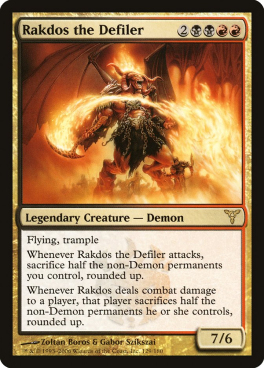


The determination gets a bit pricklier when the enemy colors have to find something they agree on. What common ground is there between cerebral blue and temperamental red, or the death-magic of black and the life-magic of green?
Well: the exemplary member of the blue-red Izzet League is a mad scientist who prizes freedom and knowledge (and realizes that fewer encumbrances give him more opportunity for knowledge, and that greater understanding gives him a wider horizon), and who's glad to blow things up in the process of research and development. The guild's philosophy is personified by its boss, the brainiac dragon wizard Niv Mizzet. And the black-green worldview appreciates that life and death are dialectic movements, and fecundity requires decay; so the Golgari Swarm serves as Ravnica's decomposers and farmers, and wrecks games with its dredge mechanic, which simultaneously fertilizes your graveyard and harvests cards from it.
In my humble opinion, the most cleverly realized guild is the white-black Orzhov Syndicate. More than red and blue, black and white have always been Magic's most clearly opposed colors. How should their differences be reconciled?
Both colors have a lot of clerics in their respective folds; so Orzhov is a church, at least in name. White values conformity; black values individualism. White wants to empower the collective; black wants to empower itself. The zone where they intersect is a kind of lawful-evil country club whose members look after each other and work towards enriching themselves as a group, and are willing to resort to unscrupulous measures to further their interests at the expense of the outgroup, provided they can do so nice and legally. So while the Orzhova Church may have been a religion at some point, they're only pantomiming the rituals of piety and emptily preaching salvation while actually operating as a pack of bankers, landlords, loan sharks, and speculators, led by the cloistered ghosts of dead oligarchs in a warped parody of a famous Marxian metaphor. ("Capital is dead labour, that, vampire-like, only lives by sucking living labour, and lives the more, the more labour it sucks.")




In short: I don't think we're going to look at any other set that fires on more cylinders than Ravnica. You'll notice I didn't have much to say about the specifics of the lore. Look: if I did, we'd be here all day, and I might as well just copy and paste articles from the wiki. Besides, Ravnica's "plot" is less interesting than its overall scenario, and the logic by it was constructed. It's far and away Magic's most successful exercise in worldbuilding, its most animated and "lived-in" demesne, and the form it ultimately attained couldn't possibly have been envisioned for any other property in any other media format. The very mechanics of Magic were the city's blueprints.
Let's review, then. We just looked at a block that originated as an array of in-game abstractions subsequently clothed in a mythos which adhered to their functional contours. Before that, we looked at a block constructed from the top-down to satisfy the parameters of a predetermined aesthetic theme.
Coldsnap (July 2006) was designed sorta from the bottom up, kind of from the top down. But we can't say that it mixed the two approaches. It actually does something completely different.


I've a good and a bad guess as to how Coldsnap happened.
My bad (as in utterly groundless) explanation for Coldsnap: somebody at Wizards in a position to make executive calls had a case of obsessive-compulsive disorder.
For a while now, we've been looking at the three-set blocks around which Magic's development and release schedules were ordered for about two decades: one big set, two small sets. The first complete block was the Mirage/Visions/Weatherlight trifecta. Though Ice Age was often considered the big set of its own block, it only had one corresponding small set: Alliances. Homelands, despite having nothing to do with Ice Age, was sometimes treated as the second set of the Ice Age block, on the basis that it came out between Ice Age and Alliances. Nerds argued about it. Should the bastard Homelands be grandfathered in to make a triplicate Ice Age block that's retroactively consistent with the later model, or should it remain an incomplete but internally consistent dyad?
Nerds argued about it.
But then—a mere eleven years after the release of Ice Age—Wizards took swift and decisive action.
Coldsnap wouldn't have been made if it wasn't for somebody, and that somebody was a person in an office at Wizards (or perhaps parent company Hasbro) felt very strongly that the Ice Age block must be both pure and complete. If it ain't got Kjeldorans and rules that refer to snow-covered lands, it's not Ice Age. If it don't got three sets, it ain't a block. The only way to solve the problem was by going back in time and making a set came out between Alliances and Mirage. But since time travel technology was still ten years away in 2006 (along with cold fusion, a viable self-driving car, and a manned mission to Mars), the next best thing was to have Magic R&D spend a few weeks throwing together a 155-card expansion that rehashed a few mechanics not used since the mid-1990s, dress it up as the "long-lost" (wink, wink) second Ice Age expansion, and belatedly but conclusively oust Homelands from the now clearly-defined Ice Age block.

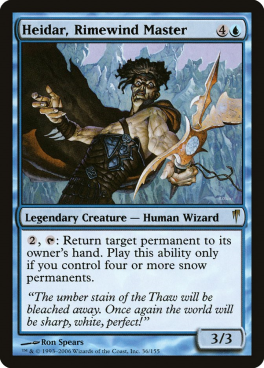


Coldsnap is sort of like a movie based on a Victorian novel of manners where everyone speaks in American accents and the bleary-eyed editor overlooked all the shots where parked cars are visible through a window in the background. It tries to pretend that it resembles a pair of sets designed at a completely different time by completely different people with completely different ideas about Magic, and isn't very convincing. Should we mention the artwork? Let's not—but, really, the least they could have done was reuse the vintage card frames. Neophyte players would have been puzzled, sure, but it wasn't like Coldsnap had any chance of being anything other than a niche product.
Only the plot is familiar: we've gone back to the past, to a year or two after the events in Alliances. A bunch of crazy ice wizards cast a spell to bring back the permanent winter, and activate a small army of unearthed Phyrexian robots to quash any objections to their scheme.
The best thing we can say about Coldsnap is that it does something new precisely by dredging up the past. Magic had never revisited an old setting before now. Not like this. Latter-day Magic does it all the time, though: Scars of Mirrodin, Return to Ravnica, Kamigawa: Neon Dynasty, etc. The basic idea is the same as Coldsnap: take an older set, bring back its popular mechanics and discard the ones that didn't work, add some new rules keywords, slap on a new coat of paint (Kamigawa but cyberpunk! Innistrad but gothic mystery/cosmic horror/harvest festival/vampire wedding! Ravnica but autumnal and paranoid!), and set it loose.
Coldsnap pandered to old men who never grew out of Magic by finally giving some of the prominent members of the Ice Age/Alliances peanut gallery in-game representation as legendary cards. King Darien (above) and Lovisa Coldeyes were to be expected. Arcum Dagsson (who now sees things Sorine Relicbane's way) and Zur (namesake of the Zuran Orb) were nice surprises. But I don't think anybody was anticipating a Marit Lage card.

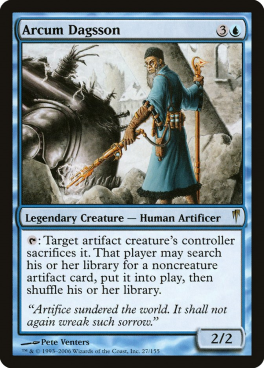

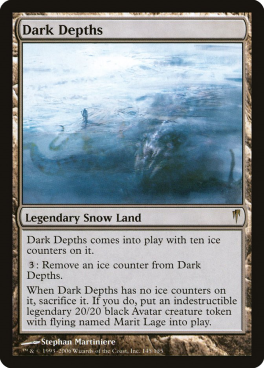
Yeah, yeah, Marit Lage technically isn't a card. Whatever.
At any rate, Coldsnap anticipates 2010–20s Magic in this, too: every time Wizards prints another Commander or Modern Masters/Horizons set, a few slots are set aside for legendary creatures representing characters quoted in the flavor text of decades-old cards remembered only by middle-aged nerds. There are people (like me) who eat this shit up. It's kind of sad.
Speaking of pandering: since Coldsnap takes place before Invasion, it gave Magic a rare opportunity to include some new Phyrexian tech and robots. After all, when would there be another chance? Yawgmoth was dead, Phyrexia was blown up, and there was no conceivable way that Magic's most fearsome and popular villains could stage a proper return.
Yessiree bob.

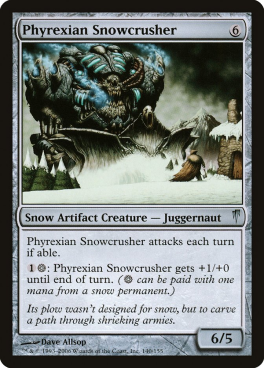
My good guess as to how Coldsnap happened: it was actually a wryly named warmup exercise for the Time Spiral block.
"Oh," Wizards asked the twenty-something geeks who bought Coldsnap boosters in spite of themselves, "are we feeling nostalgic all of a sudden? Reminded you of getting that Ice Age box for your fourteenth birthday and and trading Alliances cards during study hall when you were high school freshmen, did we? How does it feel to remember what it was like when snow-covered lands mattered, cumulative upkeep costs had to be paid, and your world seemed so full of strange and wonderful possibilities? Bet you got a little wistful for a minute, thinking about opening booster packs and playing Magic into the night with your old friends at your parents' house, listening to Better than Ezra with the windows open so you could hear the katydids, drinking Jolt Cola and enjoying each others' company for a hundred splendid nights on a summer vacation that never seemed like it would end—are we right?
"So you enjoyed that little trip down memory lane? Well—that was just the appetizer, duckies. Do you remember...Sarpadian Empires Vols. I–VI? Do you remember...Flanking? Shadow? What about...the Kobolds of Kher Keep? Do the cockles of your heart stiffen and vibrate when we tell you....slivers and thallids are back?! Open your mouths! Open your wallets!"

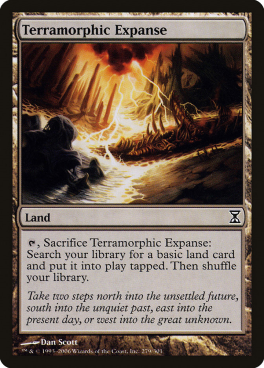


...I'm sorry. As I typed that sentence it suddenly seemed imperative that I get away from the computer and spend the rest of the afternoon in the woods. Now it's a week later (no joke) and I feel like I'm ready to return to this.
Okay. I was saying that Final Fantasy IX was the series' nostalgia episode. That's common knowledge, at least among the JRPG nerds. Self-referential content was nothing new to Final Fantasy but the throwbacks seldom amounted to much more than sporadic cameo appearances. For instance: there's a minor character in the original Final Fantasy named Princess Sara; Final Fantasy III introduces another minor character named Princess Sara. Chupon Typhon from Final Fantasy VI becomes a summon materia in Final Fantasy VII. Gilgamesh from Final Fantasy V can be made to randomly tag in and attack enemies in Final Fantasy VIII. Cloud from Final Fantasy VII is a secret character in Final Fantasy Tactics. And so on and so forth.
But Final Fantasy IX crams its allusions to earlier installments from the floor to the ceiling. You see them everywhere. Sometimes it's superficial. Other times it matters: bringing back four-person parties and characters with fixed classes (last seen in Final Fantasy III) make for a significantly different experience than IX's PlayStation predecessors.
I know what you're thinking, and Final Fantasy VI and its "everyone can learn all the magic" jibberjab doesn't count.
There wouldn't have been much point in making such a production out of classic throwbacks earlier in the series' lifespan. Final Fantasy III wasn't so much a nostalgia trip as a return to form after the aberrant sequel Final Fantasy II. When Final Fantasy IV doled out the Final Fantasy I and III tropes by the bucketful (magic crystals! black mages in pointy hats and white mages with red frilled pajamas! jumping dragoons! four elemental bosses! bahamut the not-so-friendly but helpful dragon!), it was only because those things had congealed into the franchise's signature conventions. When Final Fantasy VI and VII were in the works a few years later, SquareSoft knew it had hit its stride, and had both the resources and the talent to go for the gusto. The monumental Final Fantasy VII could only be followed by something that was equally ambitious, and with Final Fantasy VIII, the series had become something wholly other than what it was when its games cast the player in the role of a group of orphaned onion knights or a chocobo-riding vagabond.
This was when it made sense to work on a new title that was the JRPG equivalent of a memory reel set to Fatboy Slim's "Praise You." (We've come a long, long way together...)
It's worth saying that Final Fantasy IX bespeakes the series' maturation—not its exhaustion. Celebrating the past isn't necessarily the same as cannibalizing it when there's nowhere else to go. IX could be satisfying to both the veteran player and the newbie (even if all the callbacks were lost on the latter), while I doubt the same can be said for some of the cheap iOS cash grabs (Final Fantasy Record Keeper, etc.).
Oh, wait. Were were talking about Magic: The Gathering.

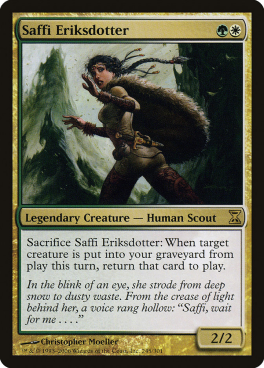


Even though we're comparing apples to oranges, the Time Spiral block is to Magic what IX would have been to Final Fantasy, had IX been designed with the same inspiration and finesse as VI or VII. It's not inaccurate to call Time Spiral the nostalgia block, but that rather sells it short.
Lore? Time Spiral has lore. There's an underlying story, and three books about it. Time rifts have opened up all across Dominaria, wreaking havoc with the very fabric of reality and bleeding the land of its mana. Plants have stopped growing, and much of the planet has become a saline dust bowl. Teferi, the planeswalker with a speciality in time magic, resolves to set things right. By sacrificing his planeswalker spark, he can...uh...and Jhoira and Freyalise are there too, and they...hm.
Who cares. It's not important. The Time Spiral books and the Time Spiral cards can be siloed off from one another, and this time, neither is any poorer for it. The nerds who want to know how the time rifts opened up, how they get closed, and how Dominaria gets its groove back can read the books. But the real story of Time Spiral is the story of Magic: The Gathering—as in, Magic the collectible card game that had been continuously expanded on and circulated for thirteen years. Boldly and unerringly, Time Spiral goes meta.
The block's first set, the eponymous Time Spiral (October 2006), lays on the nostalgia thickest of all. I don't think there's really anything to do but paste in a bunch of card images. Bear in mind that this is a comparatively piddling sample size. Indexing every specific reference would be exhausting (and it's already been done). This will just give you an idea.
(Postscript: Oh god. Once I started, I couldn't stop. Help me.)
















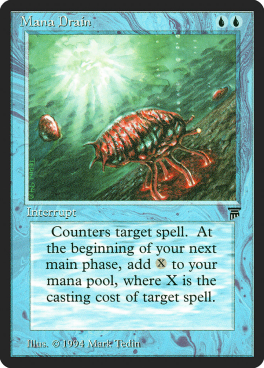






















(1) Yes, yes, that's a Time Spiral critter that cites two different cards from the days of yore. There's more of them. And also, yes, sure, I tossed in a couple of examples from the block's second set.
(2) Did you notice how many of Time Spiral's citations are illustrated by the artists responsible who worked on the originals? Wizards actually recruited quondam regulars like Anson Maddocks, Mark Poole, Daniel Gelon, etc. to contribute illustrations for Time Spiral. (I'd be interested to know if they reached out to the Foglios.)
(3) Time Spiral brings back long-defunct mechanics (flanking, buyback, morph, etc.) and creature types (thallids, slivers, rebels, etc.), and attempts to blend them all together into a coherent, balanced whole that can either be played in a limited environment (meaning that players build decks using only cards from the Time Spiral block) or as part of the rotating Standard environment. Getting to know these cards and playing with them as they made the scene must have been a blast, and I'm sorry to have missed it.
(4) Years later, the Dominaria set was developed as a "lite" sequel to Time Spiral. The crew of a rebuilt Weatherlight was at the center of the story, the mechanics emphasized "historic" cards and legendary creatures, it introduced the new "saga" enchantment, type, etc., and references to old cards and lore abounded. I enjoyed Dominaria, but it takes the basic concept of Time Spiral and dumbs it down by making it literal. It cites the textual story of Magic, whereas Time Spiral evokes the esemplastic mythos of Magic cards, Magic games, and the common experiences of Magic players.
Each part of the Time Spiral triad has its own gimmick, and we've already glanced at a few examples of the first part's. Perhaps you recognized the names on a few of the legendary cards up above: Mangara of Corondor was one of the three wizards in Mirage's backstory, Saffi Eriksdotter is the person to whom the immortal "Ach, Hans! Run!" catchphrase from Ice Age is attributed, and Ith, High Arcanist shares his name and ability with one of the only good cards to have come out of The Dark.
Time Spiral (the set, not the block) is packed with legendary cards representing characters from the early expansions, back before it became standard practice to represent important figures in cards. This would have been a very big deal to somebody who'd been playing the game since 1994—it was certainly a big deal to me when I first skimmed the card indices back in 2011–12 to catch up on what I'd missed—and once again I'm having a hard time thinking of other things to compare this to. (Charlie and Gouken becoming playable in Street Fighter Alpha and Street Fighter IV, maybe?)
A few other noteworthy ones:


Hmm. I remember seeing these years later and feeling a bit unnerved by Jaya and Lim-Dûl's' official representations. It was sort of like seeing that Dr. Claw action figure for the first time, and it made me appreciate the most probable reasons as to why Magic's designers used to be wary of turning an abstract voice in the imaginary world into a concrete, restricted image. Kaervek's lookin' good, though.
Let me just say that Jaya's card is brilliant. One of the better ideas introduced in Mercadian Masques was the spellshaper creature type, whose special ability effectively consisted of turning your cards into other cards. For instance, you can pay one green mana, discard a card, and tap Dawnstrider to make creatures deal no damage during combat—which is the same thing as casting Fog, right down to the mana cost. Dawnstrider turns any card in your hand into Fog. Hence: "spellshaper."
Jaya Ballard, Task Mage's creature type is spellshaper. Veteran players would have recognized the spells she turns cards into: Pyroblast, Incinerate, and Inferno. All of which, several years prior to Time Spiral, had been printed with flavor text attributed to Jaya Ballard, Task Mage. Jaya turns any card in your hand into one of her favorite spells.
Planar Chaos (February 2007) is only slightly less forceful a thrust into memory lane than its predecessor, and it brings a different gimmick to the table: alternate universes. Every color gets nine "planeshifted" cards, versions of old cards translated into different colors (without violating the "rules" each lives by). In the lore, these represent glimpses of worlds spawned from divergent timelines, though there's really not much to read into—unless we put on our meta-lenses. Notice how the card frames of the shifted cards are different. The idea is that we're looking into an alternate version of our timeline, one where the designers went in a different direction with the updated card frames. (Also notice that the frames from Earth-Two are unarguably superior to the ones we got here on Earth Prime.)
A sampling:







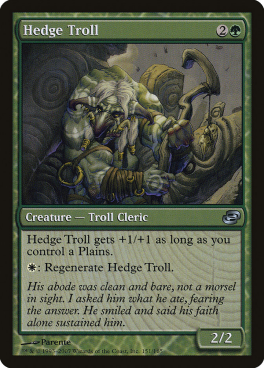

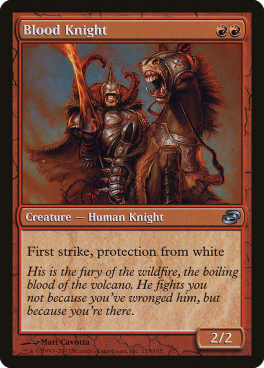





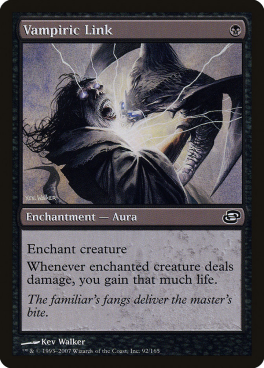
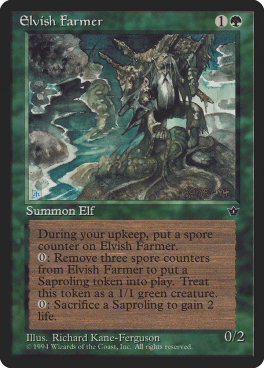



That last one's a deep cut: a reference to how the team that designed Alliances' cards, separate from the group that worked on its story and artwork, gave the prototypes gorilla-themed placeholder names.
Each color also gets a planeshifted legendary creature (sans the pretty frames), representing a version of a well-known character from a universe where events played out differently for them.
This is another story conceit that a franchise can't pull off until it's been around for a while. The Age of Apocalypse event in the X-Men comics asks: "what would have happened if Xavier were murdered before he created the X-Men?" Decades of serialization provided a field for the ramifications to extend and multiply. If Stan Lee had gotten it into his head to attempt the trick in the book's second or third year of publication, it would be only good for a one or two-issue "It's a Wonderful Life" outing instead of a sprawling, epochal event that reflected three decades of characters and continuity in the glass of a dark funhouse mirror.
The trope works a bit differently in Magic, where it's less a matter of how consistently a given character has been developed than knowing what characters have left an impression on players in the past, and calculating which of them are good candidates for the Flashpoint treatment. Like: what if Braids from the Otaria saga hadn't gone psycho?


This is a near-perfect analogue of how any decent comic book handles an alternate-timeline version of an established character. In Age of Apocalypse, we meet a version of Sabretooth who had something of an epiphany which he wasn't afforded in the mainline continuity, and he becomes an ornery but noble freedom fighter instead of continuing his freefall into a life of wanton depravity. He became one of the story's most popular characters, and it wouldn't have worked as well as it did if we didn't see areas of overlap between alternate Sabretooth and prime Sabretooth.
Braids, Conjurer Adept achieves the same effect with nothing but a name, a portrait, mana symbols, and some rules text. This is all we need to understand that, like Age of Apocalypse Sabretooth, Time Spiral Braids is the same person on a different trajectory. Whereas the narrative medium must convey this by depicting the character in action, in this particular format, the mechanics of shifted Braids' card are marvelously descriptive (provided one knows how to read them).
Green gets an Efrava-loyalist version of Jedit Ojanen, which probably doesn't mean anything to anyone who wasn't buying the Armada comics or reading the books. Red gets an alternate take on Akroma, the avenging angel from the Onslaught block, and I guess she's, uh, maybe a lot angrier in the aberrant timeline?
The shifted versions of Mirri and Crovax are from a world where Mirri landed the finishing blow against Selenia in Stronghold, and got hit with the vampire curse meant for Crovax. A couple of colorshifted cards intersect with the legendary creature cards to tell an alternate-universe vignette:




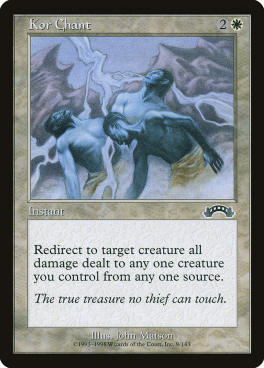

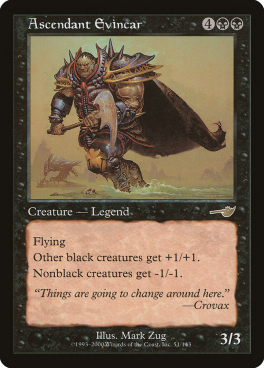

(1) It's only fair that hero Crovax and vampire Mirri get a bit more story than the others, since they debuted in the short-lived "cards as storyboards" era.
(2) The people who took charge of the story after the original plan for the Weatherlight saga was scrapped did Crovax dirty, and I'd like to believe that Crovax, Ascendant Hero was designed to retroactively annoy players at his debasement.
(3) Mirri gets screwed over in both timelines—but I'm prejudiced against catgirls, so whatever.
As its name suggests, Future Sight (May 2007) turns off the nostalgia spigot and looks to the future. Most of the cards that don't relate to the ongoing drama surrounding the time rifts are a glimpse at the shape of things to come—possibly. This time, fourteen to fifteen cards of each color (and some artifacts and lands) have been "futureshifted." Take a gander:






I can't find anything that indicates whether the futureshifted card frames were truly a trial run for the twenty-year old card design's replacement—but if so, I'm sure that players howled about it enough to put the kibosh on that idea. (And a good thing, too—I don't know how they even got past internal focus testing.) I've a kooky theory that the futureshifted card layout was a sneaky way of making people grateful for the existing frames after the colorshifted cards made them suddenly seem so appalling.
Ugly or not, these are delightfully clever. The futureshifted cards depict planes we've never seen, and have abilities and attributes that don't (or didn't) exist anywhere else. A colorless spell? A colored artifact? A land-creature? An artifact that's equipped to lands? Can that happen? There was a time when people asked the same thing about multicolor, equipment, and planeswalker cards (but we're getting a bit ahead of ourselves with the last one). Not to belabor the point, but this isn't about what might to happen in the story of Magic (cards like Sacromite Myr notwithstanding), but what the future of the game might hold.
Let's get right to the point, though: Steamflogger Boss (above) is without a doubt the most brilliant Magic card ever printed.
When my friend Jason dragged me back into Magic, I found a copy of Steamflogger Boss while sorting through his collection and had to ask him about it. (All I knew about Future Sight at the time was my inference that there had once been some experiment with new card frames, and I was relieved that it evidently hadn't taken off.)
"What does this card do?"
"It gives other riggers +1/+0 and haste."
"Sure, but what about the part about contraptions?"
"It doesn't do anything."
"What do you mean? It makes other cards assemble more contraptions. How does that work?"
"Uh, it doesn't."
"Jason, focus." (We were both smoking a lot of weed in those days, and were prone to zoning out.) "Let me read the card text to you: 'If a Rigger you control would assemble a Contraption, it assembles two Contraptions instead.' I have no idea what this means. What do contraptions do?"
"Nothing!" (Jason was by now concealing his amusement and egging me on.) "There aren't any contraptions."
"But the card says contraptions!"
"What's a contraption?"
"That's what I'm asking you!"
And so on and on.
After Jason finally explained it to me, I experienced a glimmer of sublime appreciation not altogether unlike the moment where I finally understood Marcel Duchamp's Fountain. The audacious genius of it! Imagine: the first day Future Sight went on sale, somebody somewhere, somebody who hadn't read any previews or seen any spoilers, bought a booster pack, and in its rare slot was a creature with an ability that did nothing.
Steamflogger Boss powers up other rigger creatures—but except for Steamflogger Boss, there were no other riggers. Anywhere. The rules text indicates that it doubles the number of contraptions a rigger can assemble—but this is a lot of absolutely meaningless gibberish. The futureshifted cards are supposed to be a vision of things to come, remember, and Steamflogger Boss has an ability for which no rules had yet been written.
Would contraptions get properly introduced in a later set? Perhaps, but a fat lot of good it did the kid opening Future Sight boosters and getting a rare card that's only useful if he gets ahold of three more and can theoretically have multiple Bosses on the table, all giving each other +1/+0 and haste. We've gone beyond a geek community in-joke, here. This is surely among history's most esoteric mass punkings.
This is all, regrettably, past tense. Steamflogger Boss was reprinted in one of the Un-sets, which we're not going to talk about here. Long story short: they're joke sets that would be a real hoot if they were even a tenth as funny as they imagine they are. They're not legal for play in any official formats, and I have no idea who actually buys them. A few years ago, one of these sets (I'm not looking up the name) introduced contraptions and a body of rules for them, which means Steamflogger Boss technically does something now, even if he can't do it anywhere but at the kitchen tables of people whom even Magic nerds deride as nerds. Ironically, integrating Steamflogger Boss into a gag set negated everything that made it so delightfully funny.
Unstable. That's what the set was called.
I wonder what it says about the state of latter-day Magic that when you look between the "serious" meta set from fifteen years ago and a recent "joke" meta set, it's the serious one that palpably exudes the fun the designers had making it, while the wacky, supposedly exuberant one rather feels like parlor games at an office party without any booze.



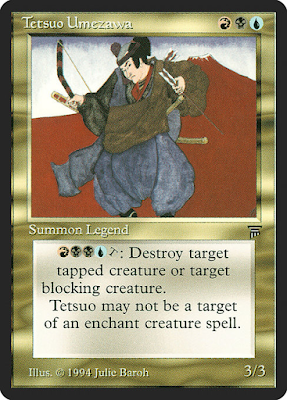


(Person who's only learning about Magic from this series here.)
ReplyDeleteWhen I was reading parts 3 and 4, I thought that I knew where this was going. After the initial promise of interesting world building, we would be in for years and years of incestuous crap, like any big pop-culture universe, be it Star Wars, DC, or Marvel.
The articles actually got me interested in giving Magic - the game - a try, as it's a blind spot in my gaming knowledge. I looked at the upcoming sets and of course, in 2022 we'll get... The Brothers' War. I then looked at a list of all Magic sets, and seeing multiple Ravnica, Zendikar, and Kamigawa sets seemed to confirm my suspicions.
But now you've cast doubt on them. I was sure the time-travelling, alternate universe stuff would be garbage - but instead it seems inspired. Who would've thought! And I just read that in 2011, Wizards stopped releasing books to accompany sets, and instead moved to publishing stories as articles on their website.
What do you know, I'm starting to get optimistic about this.
PS Happy to hear you're in a better place job- and depression-wise now, and (even though I'm enjoying them a lot), you don't really feel like working on the Magic write-ups all that much.
DeletePPS That said... if you ever feel like writing about the mechanics part of Magic, you got one guaranteed reader.
PPPS And to something you alluded to in a previous entry - would also be curious what you think of Dark Souls if you ever end up playing it, especially with your experience with older games.
You're not the first person to ask if I plan to do a Dark Souls writeup, and right now the answer is no—I can't. Don't got no TV, don't got no consoles. Moving in with some people next month, and they *might* want to get a TV and some sort of gaming machine, so we'll see...?
DeleteThe boring reason Cold Snap exists: WotC was only releasing a set in the summer every other year (the core set), and Hasbro wanted them to smooth out their revenue cycles by releasing a summer set in the off-year. The "lost third set" conceit was incidental.
ReplyDeleteHmm. I knew about Combo Winter 2: Affinity Boogaloo, but not this. Truth is more corporate than fiction.
DeleteWere you around for Time Spiral, by the way? Was it as fun as it looks?
DeleteI was not, sadly. I agree that it looks to have been a very fun period to play Standard.
DeleteSo the nostalgia era already started 15 years ago for Magic? Funny. I'm hearing just now about those cards and they've been out for a very long time. I suppose capitalism keeps chugging along even when you're not looking.
ReplyDelete